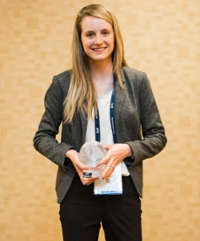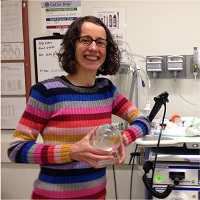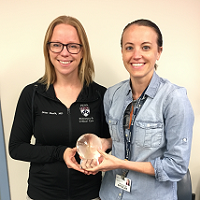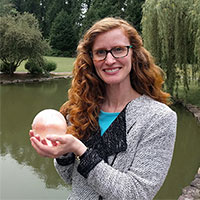2019 BAVLS Fall Cycle, First Place Winner


Pulsus Paradoxus in Cardiac Tamponade
Author: Rebecca A Israel, Camille Petri
Institution: Beth Israel Deaconess Medical Center
Early recognition of pulsus paradoxus is necessary for the timely diagnosis of cardiac tamponade. In this video, we describe the physiology underlying pulsus paradoxus and highlight the complex interactions between the cardiac and respiratory systems. We also demonstrate a technique for measuring a pulsus paradoxus using actual footage of a physical exam. Animations for this video were created using the screen recording feature of the iPad and the drawing tools built into Keynote. The script was subsequently recorded as a separate voiceover and the project edited in Final Cut Pro.
We were incredibly fortunate to work on this project with Dave Fobert who expertly guided us through the technical aspects of making a video. Dr. Richard Schwartzstein graciously provided editorial and content oversight.
It’s an honor to share our video through the BAVLS. BAVLS is an important resource for both learners and educators in pulmonary and critical care, and serves as one of many examples of how the ATS leads and supports in medical education. We commend the ATS for their commitment to promoting innovative, high-quality and open-access teaching materials. We have learned tremendously from previous winners and are excited to share our contribution.
2019 BAVLS Fall Cycle, Second Place Winner

Fluoroscopy with Bronchoscopy
Author: Ilana Roberts Krumm, MD
Institution: University of Washington
This video is the latest in a series of introductory bronchoscopy videos from the University of Washington. Fluoroscopy is commonly used when performing transbronchial biopsies, which can increase the diagnostic yield for biopsy of masses and make the procedure technically easier for bronchoscopists. However, we found that both PCCM fellows and faculty have very little fluoroscopy-specific training. This video was created to serve as a practical just-in-time training for PCCM fellows as well as faculty to fill that educational gap. The videos were created in iMovie with a combination of footage from the bronchoscopy suite and graphic illustrations, with a voice over.
With the onset of the COVID-19 pandemic and a transition to remote learning, video-based lectures have become increasingly important in medical education. BAVLS is an excellent resource of peer-reviewed, high quality content and is an important resource for medical education in Pulmonary/Critical Care.
2019 BAVLS Fall Cycle, Third Place Winner

E-Cigarettes: Everything to Know in Under 10 Minutes
Author: Arya Jahan, Jarod Olay, Sedtavut Nilaad, Laura E. Crotty Alexander MD
Institution: UC San Diego
Arya, Jarod, and Sed are students at UCSD working in the research laboratory of Dr. Laura Crotty Alexander. Throughout our years in college, we have seen that e-cigarette use is surprisingly common among our peers, despite the fact that cigarette use has been in decline with our generation. Thus began our research studies on the health effects of popular new products, like JUUL e-cigs. With the outbreak of many serious cases of E-Cigarette or Vaping Product Use-Associated Lung Injury (EVALI) in late 2019, we identified the need to provide concise information about e-cigarette use to help people make informed decisions about their health. Understanding that much of e-cigarette use occurs in high school and college aged students, we wanted to make our video entertaining and appealing to younger generations, and so our skit was born!
The BAVLS program has been an extraordinary opportunity to work towards this goal and we are thrilled and honored to have our video featured. The video format has transformed how we are able to impact our community with new research findings, by making the information more engaging and easily accessible. In addition, we are able to reach a broader audience which includes the general public and the health care providers who may deal with EVALI in their practice. We would like to thank ATS for helping us in making information about e-cig use accessible to all communities.
2019 BAVLS Spring Cycle, First Place Winner

Auto-PEEP and Ineffective Trigger
Author: Stephanie Maximous
Institution: University of Pittsburgh School of Medicine
The recognition of auto-PEEP is an integral component in the management of mechanically ventilated patients and requires careful visual assessment of ventilator waveforms. Identification and understanding of ineffective trigger are important features of a thorough evaluation for underlying intrinsic PEEP. The motivation for creating this video came from seeing my mentor, Dr. Burton Lee, demonstrate this concept several times using the simple and yet clear chair analogy that we reenact in this video. Dr. Megan Acho, our medical education fellow, and I now teach mechanical ventilation to our residents and fellows and this concept comes up every time, so we wanted to have a visual demonstration available at our fingertips or to facilitate a bit of asynchronous learning. This is the first in a series of videos we are assembling to supplement an educational curriculum on mechanical ventilation basics. To make this video, we wrote and edited the script, then filmed the chair exercise in time to a recording of the script being read aloud. I then edited and re-recorded the voice-over to be properly timed with the action in the video and added the annotations (the most pain-staking part!). The only materials we used were an iPhone for video and voice recording, iMovie software, an empty conference room with chairs, commonly found equipment like an IV pump and tracheostomy tubes from our ICU, and of course our snazzy, handcrafted t-shirts.
We are thrilled that our work is being featured amongst the diverse set of Best of ATS Video Lecture Series. BAVLS is a tremendous resource that promotes high-quality, peer-reviewed, open-access education across countless institutions in the US and internationally due to its availability on the ATS website. We are encouraged by the increasing presence of medical education in the field of pulmonary and critical care medicine and within ATS specifically and hope to continue to support this growing niche.
2019 BAVLS Spring Cycle, Second Place Winner

Introduction to Mechanical Ventilation
Author: Richard Schwartzstein
Institution: Beth Israel Deaconess Medical Center, Harvard Medical School
First encounters with a mechanical ventilatory can be very anxiety provoking for students and interns, who often view it as a “black box,” mysterious and intimidating in the corner of the patient’s room in the intensive care unit. This video is the first in a series that I am planning to make the ventilator more accessible to learners. By demonstrating that core principles of physiology, which they all encountered in their pre-clerkship courses in medical school, can explain the basic function and management of the ventilator, I hope to build on prior learning, thereby enhancing understanding and long term retention of knowledge.
The BAVLS program offers educators the opportunity to join a community of innovation in teaching. The videos are special for our students, residents, and fellows because of all the work that is done to take complicated or challenging concepts and make them understandable for our learners. I applaud the ATS for supporting this program and the future of our faculty who are committed to enhancing the care of our patients through education.
2018 BAVLS Fall Cycle, First Place Winner

Mechanical Ventilation 101: Resistance and Compliance
Author: Alison Trainor
Institution: Beth Israel Deaconess Medical Center
We created this video on compliance and resistance as part of a series of videos used to teach residents the basics of mechanical ventilation. This video was used as part of a flipped classroom model where interns and residents watch videos on mechanical ventilation prior to their medical ICU rotation and then participate in a case based discussion about a mechanically ventilated patient during their morning teaching sessions. Working as a team, we were able to draw from our different level of training and backgrounds in education to create a video that we thought would best meet the educational needs of our target audience. The videos were created by combining powerpoint, recording videos of vent screens, voice overs, and the draw feature in powerpoint.
BAVLS is a great way to highlight quality educational videos in pulmonary and critical care and to foster excitement about this new frontier in medical education. One of the benefits of the BAVLS is that it provides a collection of videos that have been reviewed to insure the content is accurate and useful. We are grateful to be honored among many other incredible videos and are thankful to our colleagues who have helped us with the video creation process.
2018 BAVLS Fall Cycle, Second Place Winner

The Acute Respiratory Distress Syndrome - The Berlin Definition
Author: Tharusan Thevathasan
Institution: Department of Anesthesiology and Intensive Care Medicine, Charité – Universitätsmedizin Berlin, Germany & Massachusetts General Hospital, Harvard Medical School
Our video lecture is about the Acute Respiratory Distress Syndrome, an acute and potentially life threatening deterioration of pulmonary gas exchange function. The video describes the transition from historic definitions of ARDS to the current definition – the so called “Berlin definition” of ARDS. It exemplifies how ARDS is caused, diagnosed and treated according to current guideline recommendations. The concept of the teaching lecture is the result of a joint team effort, including a professor, ICU attendings, a critical care fellow, medical students and a medical educationlist. The case story in this video is based on an animated patient history, visual mnemonics and whiteboard visualizations, as well as live scenes recorded at the ICU bedside of a simulation patient.
In the “era” of social media, online video-based lectures have become an increasingly used format in medical education, and may assist the “modern millennial learner” with preparing or revising classroom courses. We are convinced that the American Thoracic Society provides a powerful and peer-reviewed online course platform to share free, open-access knowledge in pulmonary and critical care medicine across the world. On behalf of all authors, we thank the ATS for its pioneering role in global barrier-free medical education.
2018 BAVLS Fall Cycle, Third Place Winner
Optimising breathing patterns in chronic respiratory disease
Co-Author: Caroline Nicolson & Annemarie Lee
Institution: Alfred Health, Monash University
Breathing dysfunction is common amongst people with chronic respiratory diseases, including chronic obstructive pulmonary disease, asthma and suppuratives lung conditions, such as bronchiectasis. Two common breathing pattern disorders are hyperventilation and upper chest breathing, which may trigger respiratory symptoms or contribute to inhibition of airway clearance therapy. This video highlights the features of breathing dysfunction and methods of assessment. It provides practical suggestions for a mix of treatment strategies designed to address breathing dysfunction and their application in chronic respiratory diseases, including some general prescription principles and common clinical scenarios.
We are delighted to share this material through the Best of the ATS Video Lecture Series. This is a great resource for clinicians, educators and learners, and provides the opportunity to share clinical experiences and knowledge through this e-learning platform.
2018 BAVLS Spring Cycle, First Place Winner

Waveform Capnography
Author: Zachary Fulkerson
Institution: Indiana University School of Medicine
Waveform capnography is a useful monitoring modality in critically ill patients. Its interpretation requires the understanding of underlying principles of respiratory physiology. This video is the first in, what I hope, will be a series of short videos in applied physiology. The video itself was simply a Powerpoint presentation with voiceover. Microsoft Excel was used to generate the capnography examples. The overall design was intentionally minimalistic with a dual screen modality used to present complimentary learning points simultaneously (e.g. waveforms paired with diagrams of pulmonary physiology).
BAVLS is an innovative platform allowing educators to share important insights in pulmonary and critical care. The peer-reviewed nature ensures quality content, and harnessing the social media arm of ATS allows for wide dissemination. It is an honor to be a part of this novel platform.
2018 BAVLS Spring Cycle, Third Place Winner

Transbronchial Biopsies
Authors: Rosemary Adamson, Siddhartha Kapnadak, Amy Morris, Patricia Kritek, Maya Sardesai, Mark Tonelli
Institution: University of Washington
This video on how to take transbronchial biopsies is the latest in a series of introductory bronchoscopy videos that I have created together with my colleagues at the University of Washington. We created these videos to provide PCCM fellows with asynchronous and just-in-time learning about bronchoscopy and I’m thrilled that they have been helpful for trainees at many institutions. We try to make these videos as practical and helpful as possible by creating them as a group, so that they provide a balanced approach to the tasks, and by shooting a lot of footage of the actual equipment used. These videos use a combination of footage from the bronch suite, from the simulation center and graphic illustrations synchronized with a voice over.
BAVLS is a fabulous resource for trainees and educators. It is a wonderful repository of useful educational videos that trainees can access by themselves and to which faculty can point trainees looking for information. It also serves as recognition for the educators who have created the content. I’m thrilled to receive this BAVLS award. Thank you to the ATS and thank you to my colleagues!
2017 BAVLS Fall Cycle, First Place Winner

Penn PET Project: Evidence-Based Inhaler Therapy for COPD
Authors: Caitlin Clancy, MD, Janae Heath, MD
Institution: Hospital of the University of Pennsylvania
We started out looking to create new content for pulmonary fellows, recognizing that they are "millennial" learners and very short of time, and wanted to make something that they could turn around and use as a teaching tool themselves. This is one of an ongoing series of videos focused on the evidence behind common pulmonary guidelines and management paradigms. We were especially interested in putting trials in historical context, and using the story of how evidence shifted based on new trials as a tool for enhancing learning. Our video team consists of Dr. Clancy and Dr. Health who create the content and storyboards together, and the animation and video editing is done by Dr. Clancy. For each video, we have faculty reviewers who are experts in the content area. Our COPD inhaler therapies video was reviewed by Dr. Mike Sims and Dr. David Lipson.
The BAVLS is a fantastic resource from the ATS. The medical education landscape is changing at lightning speed and BAVLS helps disseminate content from the educators at the leading edge. Video or e-learning is the next frontier for medical education, in addition to social media-based resource-sharing and collaboration, addressing traditional barriers of time, engagement, and access to experts. Through initiatives like BAVLS, the ATS establishes itself as leaders and innovators in medical education.
2017 BAVLS Spring Cycle, First Place Winner

Ultrasound Basics
Authors: Amy E. Morris, MD; Shailaja Hayden, MD; Qian (Grace) Chu, RN
Institution: University of Washington
"Ultrasound Basics" is the first in a series of ultrasound training videos at the University of Washington, created by a multidisciplinary team including physicians and advanced practice providers in critical care, emergency medicine and radiology. Like many institutions, we are grappling with the rapidly increasing use of point of care ultrasound (POC US) in many clinical areas, and recognize the need for minimum essential skills in this widespread technology. Our "core curriculum" of online content consists of material we feel is essential for any level of provider using ultrasound for the most common applications. These are the first modules in that effort. Each is less than 10 minutes long, to be used either as a counterpart to hands-on training for novices, or as a refresher while on a busy clinical service. "Ultrasound Basics" is a simple powerpoint format with a voiceover; the other modules in the series were created using widely available video editing software (Adobe Premiere) and the assistance of Justin Andros and our colleagues in the WWAMI Institute for Simulation in Healthcare (wish.washington.edu).
We are so pleased to be able to share our materials through the Best of the ATS Video Lecture Series. This is a wonderful resource for learners and educators alike, a way to both disseminate high quality educational materials and hopefully inspire others to create and share their own. We hope our experience will encourage others to explore multi- and interdisciplinary educational projects and enrich the pulmonary and critical care education community with their results.
2017 BAVLS Spring Cycle, Second Place Winner

Tricyclic Antidepressant Overdose – Toxicokinetics, Toxicodynamics, and Management
Authors: Ran Ran, MD; Gillian Beauchamp, MD; Robert Hendrickson, MD
Institution: Oregon Health and Science University
Tricyclic antidepressant (TCA) overdose continues to be an important topic in medical education. As an uncommon disease that can rapidly become fatal, medical providers must stay current on its pathophysiology and treatments. In today's era, memorizing guidelines can be more appealing to the busy learner than understanding mechanisms and physiology. This video is an 'electronic chalk talk' that aims to foster an understanding of TCA toxicity in order to guide management.
It's an honor to be recognized by BAVLS. Social media has dramatically expanded traditional methods of medical education and, I believe, will become the primary medium for the modern learning experience. The Video Lecture Series by ATS are pioneers in this pedagogical breakthrough. On behalf of all learners, thank you for advancing medical education.
2017 BAVLS Spring Cycle, Third Place Winner

Confirming a Diagnosis of Asthma
Authors: Amber J. Oberle, MD, Jordan W. Whitson, MD & Mohamed H. Morad, MD
Institution: Indiana University School of Medicine
Asthma is a common diagnosis but can often be difficult to confirm amidst its non-specific and common symptoms. This video assists the clinician in recognizing and confirming a diagnosis of asthma through the use of spirometry, peak expiratory flow and methacholine challenge testing. I was fortunate to have the help of Mohamed Morad who has expertise in video graphics and editing. We used green screen technology to film the presenter and used text, graphics and figures to reinforce learning points. BAVLS is a unique and innovative way to encourage a climate of education and teaching which is vital to the culture of medicine. This is just the beginning of how technology can be used to spread knowledge across the world.



